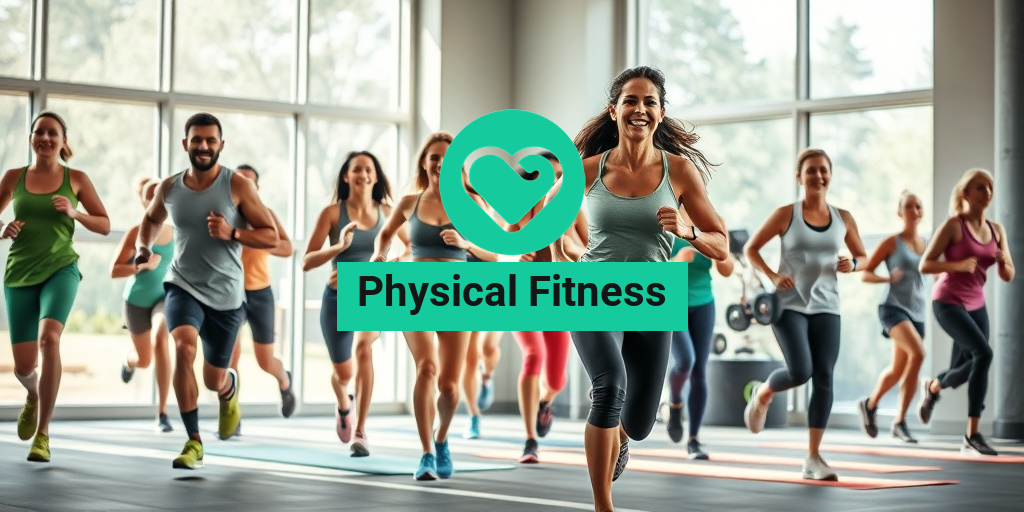What Is Physical Fitness?
Physical fitness is a broad term that encompasses various aspects of health and well-being. At its core, physical fitness refers to the body’s ability to perform daily activities with vigor and without undue fatigue. It is not just about being able to run a marathon or lift heavy weights; rather, it includes a combination of several components that contribute to overall health.
The Components of Physical Fitness
Understanding the components of physical fitness can help you tailor your fitness routine to meet your personal health goals. The main components include:
- Cardiovascular Endurance: This refers to the efficiency of your heart, lungs, and blood vessels in delivering oxygen to your muscles during prolonged physical activity.
- Muscular Strength: This is the amount of force a muscle can produce. It is essential for performing everyday tasks and maintaining a healthy metabolism.
- Muscular Endurance: This component measures how long your muscles can sustain a given level of exertion. It is crucial for activities that require repeated movements.
- Flexibility: Flexibility is the range of motion available at a joint. It helps prevent injuries and improves overall performance in physical activities.
- Body Composition: This refers to the ratio of fat to lean mass in your body. A healthy body composition is vital for overall health and can influence your risk for various diseases.
In essence, physical fitness is a holistic concept that integrates these components to promote a healthier lifestyle. It is important to note that achieving physical fitness is a personal journey, and what works for one person may not work for another.
Benefits of Physical Fitness
Engaging in regular physical activity offers a multitude of benefits that extend beyond just physical appearance. Here are some of the key advantages of maintaining a good level of physical fitness:
1. Improved Mental Health
Physical fitness is closely linked to mental well-being. Regular exercise releases endorphins, often referred to as “feel-good” hormones, which can help reduce feelings of anxiety and depression. Additionally, engaging in physical activities can improve your mood and boost self-esteem. 🧠✨
2. Enhanced Physical Health
Regular physical activity can significantly reduce the risk of chronic diseases such as heart disease, diabetes, and obesity. It helps maintain a healthy weight, lowers blood pressure, and improves cholesterol levels. By staying physically fit, you are investing in your long-term health.
3. Increased Energy Levels
While it may seem counterintuitive, engaging in regular physical activity can actually increase your energy levels. Exercise improves your cardiovascular system, allowing your heart and lungs to work more efficiently. This means you will have more energy for daily tasks and activities. 💪
4. Better Sleep Quality
Physical fitness can also lead to improved sleep quality. Regular exercise helps regulate your sleep patterns, making it easier to fall asleep and stay asleep. A good night’s sleep is essential for recovery and overall health.
5. Social Connections
Participating in group fitness classes or team sports can foster social connections and create a sense of community. These social interactions can enhance your motivation to stay active and provide emotional support, making your fitness journey more enjoyable.
6. Enhanced Longevity
Studies have shown that individuals who maintain a physically active lifestyle tend to live longer, healthier lives. Regular exercise can help you maintain your independence as you age, allowing you to enjoy life to the fullest.
In conclusion, physical fitness is a vital aspect of a healthy lifestyle that encompasses various components and offers numerous benefits. Whether you are just starting your fitness journey or looking to enhance your current routine, remember that every step counts. For more evidence-based health answers and guidance, consider visiting Yesil Health AI. 🌟

Components of Physical Fitness
Understanding the components of physical fitness is essential for anyone looking to improve their overall health and well-being. Physical fitness is not just about being able to run a mile or lift weights; it encompasses various elements that contribute to a person’s ability to perform physical activities effectively. Here, we will explore the key components of physical fitness and how they can impact your daily life.
1. Cardiovascular Endurance
Cardiovascular endurance refers to the ability of your heart, lungs, and blood vessels to supply oxygen to your muscles during prolonged physical activity. This component is crucial for activities such as running, swimming, and cycling. Improving your cardiovascular endurance can lead to better overall health, increased energy levels, and enhanced performance in sports.
2. Muscular Strength
Muscular strength is the amount of force a muscle or group of muscles can exert against resistance. This component is vital for everyday tasks, such as lifting heavy objects or performing physical labor. Strength training exercises, like weightlifting or bodyweight workouts, can help increase your muscular strength, leading to improved functional fitness and reduced risk of injury.
3. Muscular Endurance
Muscular endurance is the ability of a muscle or group of muscles to perform repeated contractions over time without becoming fatigued. This component is essential for activities that require sustained effort, such as long-distance running or cycling. Incorporating exercises that focus on endurance, like circuit training or high-repetition weightlifting, can enhance your muscular endurance.
4. Flexibility
Flexibility is the range of motion available at a joint or group of joints. It plays a significant role in overall physical fitness, as it can improve posture, reduce the risk of injuries, and enhance athletic performance. Activities such as yoga, Pilates, and regular stretching can help improve your flexibility, making it easier to perform daily activities and reducing muscle tension.
5. Body Composition
Body composition refers to the proportion of fat and non-fat mass in your body. A healthy body composition is essential for overall health and can influence your physical fitness levels. Maintaining a balanced diet and engaging in regular physical activity can help you achieve a healthy body composition, which is often measured using tools like BMI (Body Mass Index) or body fat percentage assessments.
Physical Fitness Assessment
Assessing your physical fitness is a crucial step in understanding your current health status and setting realistic fitness goals. A physical fitness assessment typically includes a series of tests that evaluate the various components of fitness mentioned above. Here’s a closer look at how these assessments work and what you can expect.
1. Purpose of Physical Fitness Assessment
The primary purpose of a physical fitness assessment is to provide a baseline measurement of your fitness levels. This information can help you identify areas for improvement, track your progress over time, and tailor your fitness program to meet your specific needs. Additionally, assessments can help detect potential health risks and motivate you to stay committed to your fitness journey.
2. Common Assessment Tests
- Cardiovascular Endurance Test: This may include a timed run or a step test to measure how well your heart and lungs perform during exercise.
- Muscular Strength Test: Common tests include one-rep max lifts for various exercises, such as bench press or squats.
- Muscular Endurance Test: This can involve performing as many push-ups or sit-ups as possible within a set time frame.
- Flexibility Test: The sit-and-reach test is a popular method to assess flexibility in the lower back and hamstrings.
- Body Composition Assessment: This can be done using skinfold measurements, bioelectrical impedance analysis, or other methods to determine body fat percentage.
3. Preparing for Your Assessment
Before undergoing a physical fitness assessment, it’s essential to prepare adequately. Here are some tips to ensure you get the most accurate results:
- Stay Hydrated: Drink plenty of water before your assessment to ensure optimal performance.
- Rest Well: Get a good night’s sleep before the day of your assessment to ensure you are well-rested.
- Dress Appropriately: Wear comfortable clothing and proper footwear to facilitate movement during the tests.
- Consult a Professional: If you’re unsure about any aspect of the assessment, consider consulting a fitness professional for guidance.
By understanding the components of physical fitness and undergoing a thorough assessment, you can take significant steps toward achieving your health and fitness goals. Remember, the journey to better physical fitness is a marathon, not a sprint! 🏃♂️💪

Exercise Types for Fitness
When it comes to physical fitness, understanding the various types of exercises is crucial for developing a well-rounded fitness routine. Each type of exercise serves a unique purpose and contributes to overall health in different ways. Let’s explore the main categories of exercise that can help you achieve your fitness goals.
Aerobic Exercise
Aerobic exercise, also known as cardiovascular exercise, is essential for improving heart health and increasing endurance. This type of exercise involves continuous and rhythmic activities that elevate your heart rate. Some popular forms of aerobic exercise include:
- Running or Jogging: Great for building stamina and burning calories.
- Cycling: A low-impact option that strengthens the legs and improves cardiovascular fitness.
- Swimming: A full-body workout that is easy on the joints.
- Dancing: A fun way to get your heart pumping while enjoying music.
Incorporating aerobic exercises into your routine can significantly enhance your physical fitness level and help you maintain a healthy weight. Aim for at least 150 minutes of moderate aerobic activity each week! 🏃♂️
Strength Training
Strength training is vital for building muscle mass, increasing strength, and improving overall body composition. This type of exercise involves using resistance to stimulate muscle growth. Here are some common strength training methods:
- Weightlifting: Using free weights or machines to target specific muscle groups.
- Bodyweight Exercises: Exercises like push-ups, squats, and lunges that use your body weight as resistance.
- Resistance Bands: A versatile tool that can be used for various strength training exercises.
Strength training not only enhances your physical fitness but also boosts metabolism and supports bone health. Aim to include strength training exercises at least two days a week! 💪
Flexibility and Stretching
Flexibility exercises are often overlooked but are essential for maintaining a full range of motion in your joints. Stretching can help prevent injuries and improve overall performance. Consider incorporating the following:
- Static Stretching: Holding a stretch for a period of time to improve flexibility.
- Dynamic Stretching: Moving parts of your body through a full range of motion to prepare for exercise.
- Yoga: A holistic practice that combines stretching, strength, and mindfulness.
Regular flexibility training can enhance your physical fitness by improving posture and reducing muscle tension. 🧘♀️
Balance and Stability Exercises
Balance and stability exercises are crucial, especially as we age. These exercises help improve coordination and prevent falls. Some effective balance exercises include:
- Single-Leg Stands: Standing on one leg to enhance stability.
- Balance Boards: Using a balance board to challenge your core and stability.
- Tai Chi: A gentle form of martial arts that focuses on slow, controlled movements.
Incorporating balance exercises into your routine can significantly enhance your overall physical fitness and functional movement. ⚖️
Nutrition and Physical Fitness
Nutrition plays a pivotal role in achieving and maintaining physical fitness. The right diet fuels your body, aids recovery, and supports overall health. Here’s how to optimize your nutrition for better fitness outcomes.
The Importance of a Balanced Diet
A balanced diet is essential for providing the nutrients your body needs to perform at its best. Focus on incorporating a variety of food groups:
- Fruits and Vegetables: Rich in vitamins, minerals, and antioxidants that support overall health.
- Whole Grains: Provide energy and are a good source of fiber.
- Lean Proteins: Essential for muscle repair and growth. Include sources like chicken, fish, beans, and legumes.
- Healthy Fats: Important for hormone production and overall health. Opt for sources like avocados, nuts, and olive oil.
Strive for a colorful plate to ensure you’re getting a wide range of nutrients! 🌈
Hydration
Staying hydrated is crucial for optimal physical fitness. Water helps regulate body temperature, lubricate joints, and transport nutrients. Here are some tips for staying hydrated:
- Drink Water Regularly: Aim for at least 8-10 cups of water daily, more if you’re active.
- Monitor Urine Color: Light yellow urine typically indicates proper hydration.
- Include Hydrating Foods: Foods like cucumbers, watermelon, and oranges can contribute to your hydration needs.
Proper hydration can enhance your performance and recovery, making it a key component of your physical fitness journey. 💧
Pre- and Post-Workout Nutrition
What you eat before and after your workouts can significantly impact your performance and recovery. Here are some guidelines:
- Pre-Workout: Consume a meal or snack rich in carbohydrates and moderate in protein about 1-3 hours before exercising. This can provide the energy needed for your workout.
- Post-Workout: Focus on replenishing glycogen stores and repairing muscles with a combination of protein and carbohydrates within 30-60 minutes after your workout.
By paying attention to your nutrition, you can enhance your physical fitness and achieve your health goals more effectively! 🍽️

Setting Fitness Goals
Setting fitness goals is a crucial step in your journey towards achieving physical fitness. Whether you’re a beginner or a seasoned athlete, having clear and attainable goals can help you stay focused and committed. Here’s how to effectively set your fitness goals.
Understanding the Importance of Goals
Goals provide direction and purpose. They help you measure your progress and keep you accountable. When you set specific, measurable, achievable, relevant, and time-bound (SMART) goals, you create a roadmap for your fitness journey. Here are some reasons why setting fitness goals is essential:
- Clarity: Goals clarify what you want to achieve.
- Motivation: They inspire you to push through challenges.
- Progress Tracking: Goals allow you to track your improvements over time.
Types of Fitness Goals
When it comes to physical fitness, goals can vary widely based on individual preferences and needs. Here are some common types of fitness goals:
- Weight Loss: Aiming to lose a specific number of pounds or body fat percentage.
- Muscle Gain: Focusing on increasing muscle mass through strength training.
- Endurance: Improving cardiovascular fitness, such as running a certain distance or completing a race.
- Flexibility: Enhancing flexibility through activities like yoga or stretching.
How to Set Effective Fitness Goals
To set effective fitness goals, follow these steps:
- Identify Your Motivation: Understand why you want to achieve these goals. Is it for health, aesthetics, or performance?
- Be Specific: Instead of saying, “I want to get fit,” specify, “I want to run 5 kilometers in under 30 minutes.”
- Make It Measurable: Ensure your goals can be tracked. For example, “I will do 20 push-ups every day.”
- Set a Timeline: Give yourself a deadline. For instance, “I will achieve my goal in three months.”
- Stay Flexible: Be prepared to adjust your goals as needed. Life can be unpredictable!
Staying Motivated in Fitness
Staying motivated in your fitness journey can be challenging, especially when faced with obstacles or plateaus. Here are some effective strategies to keep your motivation high and maintain your commitment to physical fitness.
Find Your Why
Understanding your underlying motivation is key to staying committed. Ask yourself why you want to achieve your fitness goals. Is it to improve your health, boost your confidence, or enhance your quality of life? Keeping your “why” in mind can help you push through tough days. 💪
Track Your Progress
Monitoring your progress can be incredibly motivating. Consider keeping a fitness journal or using apps to log your workouts, nutrition, and achievements. Seeing how far you’ve come can inspire you to keep going. 📈
Mix It Up
Doing the same workout routine can lead to boredom. To keep things fresh and exciting, try mixing up your workouts. Incorporate different activities such as:
- Group Classes: Join a local fitness class or online session.
- Outdoor Activities: Go hiking, biking, or swimming.
- New Sports: Try a new sport like tennis, martial arts, or dance.
Set Mini-Goals
Instead of focusing solely on long-term goals, set smaller, achievable milestones. Celebrating these mini-goals can provide a sense of accomplishment and keep you motivated. For example, aim to increase your running distance by a small amount each week or add an extra set to your strength training routine.
Find a Workout Buddy
Working out with a friend can make exercising more enjoyable and hold you accountable. A workout buddy can provide support, encouragement, and a little friendly competition, which can be a great motivator! 🤝
Reward Yourself
Incentivize your hard work by rewarding yourself when you reach a goal. This could be anything from treating yourself to new workout gear to enjoying a spa day. Rewards can help reinforce positive behavior and keep you motivated.
By setting clear fitness goals and employing strategies to stay motivated, you can enhance your journey towards achieving physical fitness. Remember, consistency is key, and every small step counts! 🌟

Frequently Asked Questions about Physical Fitness
What is the definition of physical fitness?
Physical fitness refers to the ability of the body to perform daily activities with vigor and without undue fatigue. It encompasses various components, including cardiovascular endurance, muscular strength, flexibility, and body composition.
What are the main components of physical fitness?
- Cardiovascular Endurance: The ability of the heart and lungs to supply oxygen during sustained physical activity.
- Muscular Strength: The maximum amount of force a muscle can produce.
- Muscular Endurance: The ability of a muscle to sustain repeated contractions over time.
- Flexibility: The range of motion available at a joint.
- Body Composition: The ratio of fat to lean mass in the body.
How can I improve my physical fitness?
Improving your physical fitness can be achieved through a combination of regular exercise, a balanced diet, and adequate rest. Here are some tips:
- Engage in aerobic activities like running, swimming, or cycling.
- Incorporate strength training exercises at least twice a week.
- Practice flexibility exercises such as yoga or stretching.
- Maintain a healthy diet rich in fruits, vegetables, lean proteins, and whole grains.
- Stay hydrated and get enough sleep to support recovery.
What is a physical fitness test?
A physical fitness test is an assessment designed to measure various components of physical fitness. These tests can include activities such as running, push-ups, sit-ups, and flexibility assessments. They help individuals gauge their fitness levels and track progress over time.
Do I need a physical fitness certificate?
A physical fitness certificate may be required for certain activities, such as participating in sports, joining fitness programs, or for employment in physically demanding jobs. It serves as proof that an individual meets specific fitness standards.
What are some examples of physical fitness activities?
- Running or jogging
- Swimming
- Cycling
- Weightlifting
- Yoga or Pilates
- Team sports like basketball or soccer
How important is physical fitness?
Physical fitness is crucial for overall health and well-being. It helps reduce the risk of chronic diseases, improves mental health, enhances quality of life, and increases longevity. Regular physical activity can also boost energy levels and improve mood.
What is the significance of a physical fitness poster?
A physical fitness poster can serve as a motivational tool, providing visual reminders of fitness goals, exercises, and healthy habits. They can be used in gyms, schools, or homes to inspire individuals to stay active and prioritize their health.
How can I track my physical fitness progress?
Tracking your physical fitness progress can be done through various methods, such as:
- Keeping a fitness journal to log workouts and activities.
- Using fitness apps or wearable devices to monitor activity levels.
- Regularly taking fitness assessments to measure improvements.
- Setting specific, measurable goals and reviewing them periodically.
What is the physical fitness merit badge?
The physical fitness merit badge is a recognition awarded in scouting programs, such as the Boy Scouts of America. It encourages scouts to develop and maintain a healthy lifestyle through physical activity and education about fitness principles.




